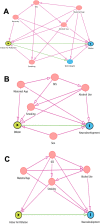DNA methylation as a potential mediator of the association between indoor air pollution and neurodevelopmental delay in a South African birth cohort
- PMID: 36855151
- PMCID: PMC9972733
- DOI: 10.1186/s13148-023-01444-6
DNA methylation as a potential mediator of the association between indoor air pollution and neurodevelopmental delay in a South African birth cohort
Abstract
Background: Exposure to indoor air pollution during pregnancy has been linked to neurodevelopmental delay in toddlers. Epigenetic modification, particularly DNA methylation (DNAm), may explain this link. In this study, we employed three high-dimensional mediation analysis methods (HIMA, DACT, and gHMA) followed by causal mediation analysis to identify differentially methylated CpG sites and genes that mediate the association between indoor air pollution and neurodevelopmental delay. Analyses were performed using data from 142 mother to child pairs from a South African birth cohort, the Drakenstein Child Health Study. DNAm from cord blood was measured using the Infinium MethylationEPIC and HumanMethylation450 arrays. Neurodevelopment was assessed at age 2 years using the Bayley Scores of Infant and Toddler Development, 3rd edition across four domains (cognitive development, general adaptive behavior, language, and motor function). Particulate matter with an aerodynamic diameter of 10 μm or less (PM10) was measured inside participants' homes during the second trimester of pregnancy.
Results: A total of 29 CpG sites and 4 genes (GOPC, RP11-74K11.1, DYRK1A, RNMT) were identified as significant mediators of the association between PM10 and cognitive neurodevelopment. The estimated proportion mediated (95%-confidence interval) ranged from 0.29 [0.01, 0.86] for cg00694520 to 0.54 [0.11, 1.56] for cg05023582.
Conclusions: Our findings suggest that DNAm may mediate the association between prenatal PM10 exposure and cognitive neurodevelopment. DYRK1A and several genes that our CpG sites mapped to, including CNKSR1, IPO13, IFNGR1, LONP2, and CDH1, are associated with biological pathways implicated in cognitive neurodevelopment and three of our identified CpG sites (cg23560546 [DAPL1], cg22572779 [C6orf218], cg15000966 [NT5C]) have been previously associated with fetal brain development. These findings are novel and add to the limited literature investigating the relationship between indoor air pollution, DNAm, and neurodevelopment, particularly in low- and middle-income country settings and non-white populations.
Keywords: Cord blood; Epigenetics; Neurodevelopment; Newborn DNA methylation; Particulate matter.
© 2023. The Author(s).
Conflict of interest statement
All authors declare they have no actual or potential competing interests.
Figures


Similar articles
-
DNA methylation as a potential mediator of the association between prenatal tobacco and alcohol exposure and child neurodevelopment in a South African birth cohort.Transl Psychiatry. 2022 Sep 30;12(1):418. doi: 10.1038/s41398-022-02195-3. Transl Psychiatry. 2022. PMID: 36180424 Free PMC article.
-
In-utero exposure to indoor air pollution or tobacco smoke and cognitive development in a South African birth cohort study.Sci Total Environ. 2022 Aug 15;834:155394. doi: 10.1016/j.scitotenv.2022.155394. Epub 2022 Apr 20. Sci Total Environ. 2022. PMID: 35460774 Free PMC article.
-
DNA methylation mediates the effect of maternal smoking on offspring birthweight: a birth cohort study of multi-ethnic US mother-newborn pairs.Clin Epigenetics. 2021 Mar 4;13(1):47. doi: 10.1186/s13148-021-01032-6. Clin Epigenetics. 2021. PMID: 33663600 Free PMC article.
-
Newborn differential DNA methylation and subcortical brain volumes as early signs of severe neurodevelopmental delay in a South African Birth Cohort Study.World J Biol Psychiatry. 2022 Oct;23(8):601-612. doi: 10.1080/15622975.2021.2016955. Epub 2022 Jan 12. World J Biol Psychiatry. 2022. PMID: 34895032 Free PMC article.
-
Ambient air pollution and pregnancy outcomes: A comprehensive review and identification of environmental public health challenges.Environ Res. 2018 Nov;167:144-159. doi: 10.1016/j.envres.2018.07.008. Epub 2018 Jul 5. Environ Res. 2018. PMID: 30014896 Review.
Cited by
-
Impact of air pollution and occupational inhalation exposures on neurodegenerative disorders: An epigenetic perspective.iScience. 2025 Jun 4;28(7):112825. doi: 10.1016/j.isci.2025.112825. eCollection 2025 Jul 18. iScience. 2025. PMID: 40599315 Free PMC article. Review.
-
Contributions of prenatal risk factors and neonatal epigenetics to cognitive outcome in children born very preterm.Dev Psychol. 2024 Sep;60(9):1606-1619. doi: 10.1037/dev0001709. Epub 2024 Feb 15. Dev Psychol. 2024. PMID: 38358663 Free PMC article.
-
Air pollution and pregnancy.Semin Perinatol. 2023 Dec;47(8):151838. doi: 10.1016/j.semperi.2023.151838. Epub 2023 Oct 10. Semin Perinatol. 2023. PMID: 37858459 Free PMC article.
-
Epigenome-Wide Association Study of Depressive Symptoms in Black Women in the InterGEN Study.Int J Mol Sci. 2024 Jul 12;25(14):7681. doi: 10.3390/ijms25147681. Int J Mol Sci. 2024. PMID: 39062924 Free PMC article.
-
Genetic etiology of autism spectrum disorder in the African population: a scoping review.Front Genet. 2024 Sep 26;15:1431093. doi: 10.3389/fgene.2024.1431093. eCollection 2024. Front Genet. 2024. PMID: 39391062 Free PMC article.
References
-
- Christensen GM, Rowcliffe C, Chen J, Vanker A, Koen N, Jones MJ, Gladish N, Hoffman N, Donald K, Wedderburn CJ, Kobor MS, Zar H, Stein DJHA, Hüls A. In-utero exposure to indoor air pollution or tobacco smoke and cognitive development in a South African birth cohort study. Sci Total Environ. 2022;834:155394. doi: 10.1016/j.scitotenv.2022.155394. - DOI - PMC - PubMed
Publication types
MeSH terms
Grants and funding
LinkOut - more resources
Full Text Sources
Medical
Research Materials
Miscellaneous

